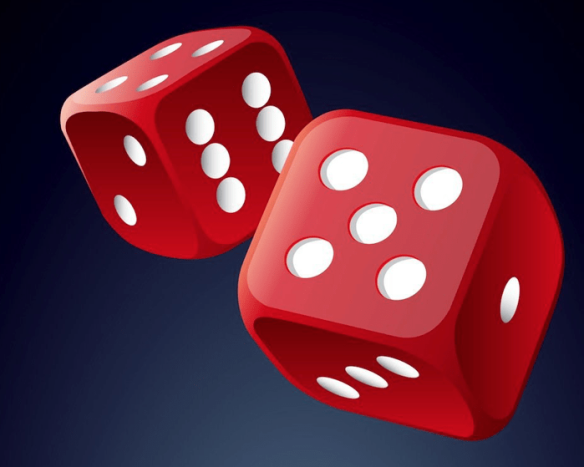
In this post I quoted in full a passage from The Traveller Adventure, which describes how to handle Situation Throws in Classic Traveller.
I’m following up with a few more posts addressing specific portions of that passage. None of this is any sort of declaration about how people are “supposed” to play the game. This is my approach, based my thinking after digging into the original Traveller rules.
In this post I’m addressing this portion:
Situation Throws: In the absence of any other guidance, the referee may always resort to the situation throw. When an incident first occurs, throw two dice to determine its relative severity. A low roll means that it is easy, a high roll means comparative difficulty. The number achieved is now the situation number. The player characters involved, when they attempt to deal with the situation, must roll the situation number or higher on two dice.
Now, this is fascinating to me for several reasons. The text suggests that if you don’t know what the difficulty should be for a Throw, you should generate the Throw randomly.
I think this is brilliant.
First, it relieves the Referee of the burden of determining how hard something is.
After all, if a fictional airlock gets stuck on a fictional ship during the circumstances of a fictional starship battle, how hard would it be to force that airlock open? Do you know? I know I don’t know. We don’t have enough information–and we never will–to truly know exactly what forces, what damage, what materials, and so and so on should factor into the difficulty of forcing the door open.
Many RPGs use a mechanic where the Referee must determine the difficulty of a task. Examples include Burning Wheel, MegaTraveller, HeroQuest and so many games it wouldn’t be worth trying to name any more. And yet, despite it being a common feature in RPG design, when I’m asked to apply it such rule rubs me the wrong way. Especially in a game like Traveller which assumes a certain level of technical level-headedness and a sense that physics and science as we know them will apply. But, again, even if everyone at the game table was a MIT doctoral candidate, there’s no way to know how difficult certain things are going to be since the reality of the situation cannot be tested and measured.
So, for this one reason I love this idea of randomly rolling to determine the Throw required for success.
And this folds into the second reason why I think this is so smart:
As I’ve written here, here, and here I think the role of the Referee in Classic Traveller is that of an impartial adjudicator of actions and choices of the Player Characters, and the cause-and-effect results on the fictional world around the Player Character and the reaction of that world back at the Player Characters. In such a style of play I am not trying to lead the characters toward any sort of result, I am not trying to stymie their efforts with any agenda on my part, I have not plot I am trying to steer them toward.
But here’s the thing: As a Referee I might set the difficulty high for a roll if I want the Player Characters to fail. Or might set the difficulty low if that leads the path I want the Player Characters to follow. In either case I am not being an impartial adjudicator, but using the rules to nudge the players to certain results, choices, or actions. But since I want to Referee Traveller as an impartial adjudicator, I don’t need a tool like that.
In fact, what I really need is an impartial method of determining difficulty when I have no other information or rules to fall back on. And this method–rolling 2D6 to randomly determine the difficulty of a Throw offers me exactly this.
This doesn’t mean the Referee has no say in the relative value of a Throw’s difficulty. For example, if the situation seems like it should be difficult or challenging the Referee can choose to roll D6+6 rather than the default bell curve of 2D6.

The passage above in The Traveller Adventure continues on with more interesting ideas.
First, this sentence:
It is even possible for a referee to make the situation number greater than 12, thus making success impossible unless the players can provide necessary skills or tools with DMs to get their throw also above 12.
So the Referee could choose to roll D6+8 for a Throw’s difficulty (providing a range of 9-14 for the Throw) or any other weighted roll he wishes.
In other case the Referee is not deciding how difficult the situation at hand will be. Even if he weights the roll (which he should do if he has a sense of whether the situation is relatively easy or hard) the actual result is still random and impartial.
Second, this text is found in every edition of the Basic Traveller rules:
Rolls by the referee may be kept secret, or partially concealed depending on their effects. In situations where the players would not actually know the results of the roll, or would not know the exact roll made, the referee would make the roll in secret.
That passage is expanded upon on page 29 of The Traveller Adventure:
SECRECY
Die rolls may be performed either secretly, by the referee, or openly, by the players. Sometimes, the adventure of the scenario is reflected in the die rolling and the characters really need to be able to throw the dice themselves. Other times, the referee and the scenario are better served if the players are not aware of the exact rolls to be made. Sometimes the purpose or even the existence of die rolls should be concealed.An important principle to remember is that die roils should not be allowed to get in the way of the game. If the players are thinking about their die rolls rather than about what is “really happening” in the game, the referee should consider increasing the number of secret die rolls.
Open Die Rolls: The referee should generally allow the players to perform their own combat die rolls and rolls for other simple actions in which success or failure is immediately visible.
Secret Die Rolls: The referee should keep secret all die rolls whose outcomes are not immediately visible and those whose chances of success, if known, would reveal things the characters should not know. For example, the referee should perform all rolls if the characters are gambling at a casino, in order to allow the possibility of the house having rigged the tables.
I think this is a useful tool for the Referee to keep in mind when using the rules mentioned above. Thus, if the Player Character with Engineering wants to force the airlock and the Referee decides to randomly determine the difficulty, he might have the Player roll one D6 and he himself roll the second D6 in secret. In this way the Player Character might end upon with a sense of difficult the situation is. In other cases the Referee might want to keep the Throw value a secret. And in other situations again the Referee might want to present the difficulty of the Throw.
I personally prefer to let the Players know the odds of a situation. This helps the process of making a decision more interesting in my view. More information means their decisions are more meaningful, whereas decisions without information are merely guesses. But I think there is something value in this approach of keeping rolls or portions of rolls secret and it is something I want to think about.
That said there are plenty of times where the Players don’t need to know at all about what is being rolled and keeping those rolls a secret will definitely help the Players stay in the fictional space of the game.

Situational Rolls sound like they take away from player character purpose in a scene.
Hi Shawn,
Not sure what you mean by that.
Can you explain further?
I’ll do a video on the topic.
Ummm… okay.
But to be clear (on my front at least, about how I Referee and how the quotes from The Traveller Adventure suggest how to play the game):
1) The PCs get into a situation of crisis or trouble that demands action with uncertain results
2) The PCs take action
3) The Referee adjudicates, based on all the fictional details present and his own judgment, the outcome of that action
4) However, if the Referee is uncertain how things might turn out, he turns to a dice roll, with the a Throw number, DMs based on fictional circumstances (actions of the PCs, skills, and so on), and a 2D6 roll.
The actions of the PCs drive what is happening. Nothing can happen without the PCs.
So I am confused by your comment.
Way back. the guys I normally rag’d with introduced a luck roll – inspired by the game Flashing Blades, modified by GURPS later, and then somewhere along the line it just became a variant use of the reaction table present in many games. And that became a way of determining task difficulties – ‘lets see how lucky (or not) you are with this mishap and we’ll see how difficult it is to resolve’. So a similar mechanic by a more round-about means. Not used very often, but used. More often, used to determine other factors – do you have time, do you have access to relevant information & tools, do you have the spare parts for that? The results of which could give say a +/- to a stated difficulty, even if it was just the default 8+.
Pretty much related to (or a derivative of) what you’ve described when you resolve it all out. Didn’t realise it was there in the rules all along.
And I see it as a useful tool for helping keep the game fair. If you think you as ref might have a bias or some niggle with the players for some reason – just let the dice decide and move on.
I am really enjoying your Classic Traveller posts. I don’t have anything worthwhile to contribute except to say, you’ve got a fan.